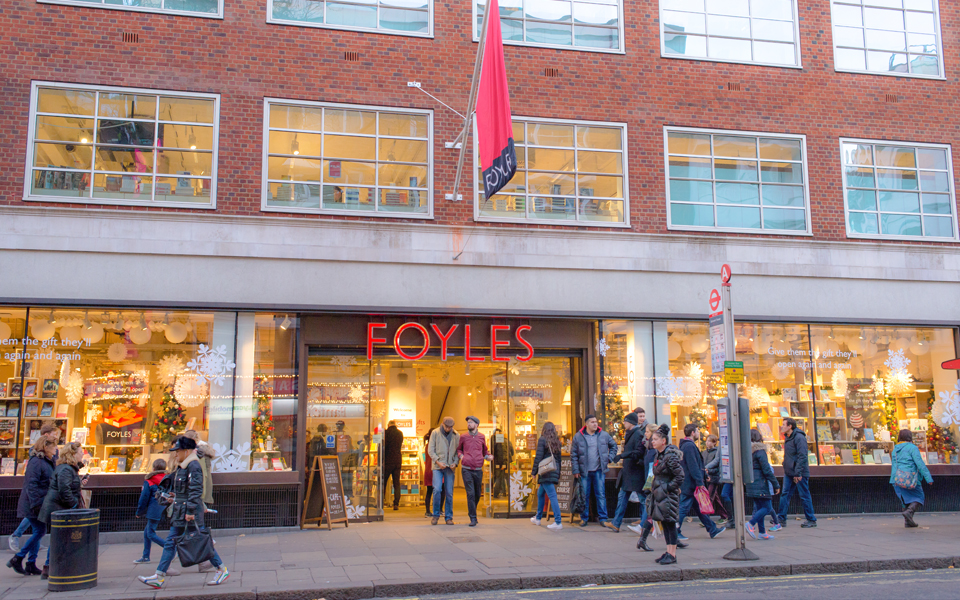Roger Tagholm
Foyles on London’s Charing Cross Road is surely the most famous bookstore in the world. It is like a great ocean liner of books that has been berthed on the street for the last 115 years. Many in the UK book industry have been voyaging on it for decades; they have grown up with it. In a changing world, it has been a constant; people care about its future – hence the continuing reaction to its acquisition by Waterstones, or, more accurately, by Waterstones’ owner Elliott Advisors.
I first went to Foyles in the early Seventies to buy past exam papers which were displayed by subject in wooden cubby holes. This is not just a pre-digital memory; it is pre-pre-pre-digital, almost the London of pea-souper fogs in fact. Or so it seems in memory; the tendency is always to over romanticize these things.
There was no shop like it. The store guide on the ground-floor was laid out by floor. To find the right floor for your chosen subject you had to read the entire list. There was no single, alphabetical list with the floor listed next to it. No, that wasn’t the way of this loveably, illogical shop whose name, incidentally, read Foyles on side of the building, without an apostrophe, and Foyle’s on the other.
There was a rickety lift with one of those concertina-style sliding metal doors, and a payment system – oh my goodness, the payment system – that was legendary. This may be a familiar story to those over 40 in the UK book industry, but it is worth repeating here for a new audience. Payment was not made in the department in which a book was purchased. No, no – that would have been too convenient for customers. Instead, the bookseller would give customers a receipt which they had to take around the corner to a wooden payment booth. The receipt was then authorised and the customer came back to the department to collect his or her books. It could take many minutes to complete a transaction.
Inevitably, this led to confusion and many fabulous signs were erected by staff to help. One barked: ‘READ THIS: YOU ARE NOW LEAVING THE EDUCATION DEPT.PLEASE GET A BILL FROM THE DESK – BACK AND AROUND TO THE LEFT’ There was also a Tolkien poster on which a Hobbit whispered: ‘Psst! Is this the way to the Stairs?’
But let us not get trapped in the past. In 2014, the latest incarnation of Foyles had a huge party, one of the very few times that publishers and authors have gathered for the launch of a bookshop. Waterstones’ MD James Daunt was among the guests. “This is a serious, serious investment in physical bookselling,” he said as he gazed around in awe. I wonder if he knew he would one day own the place.
All the talk now is of whether the stores – Foyles has a total of seven,, including the flagship Charing Cross Road store – will adopt Waterstones’ systems. Granta editor Anne Meadows told the Bookseller: “What Foyles is so brilliant at is more eclectic book-buying, particularly literary and experimental titles. I hope there won’t be a more centralised buying system.”
Daunt has sought to reassure publishers on this point, saying: “There absolutely won’t be a more centralised buying system. We don’t want to turn Foyles into branches of Waterstones, that is 100% not happening.”
Foyles will undoubtedly benefit from having more money behind it and – inevitably – betters terms from publishers in due course. Everyone in the industry hopes the name remains and given that Waterstones did not rebrand Hatchards on Piccadilly or Hodges Figges in Dublin, one assumes – and Daunt has said as much – that it will take the same approach with Foyles. The world is homogenised enough as it is: we do not travel to foreign countries to visit Starbucks.
So I join the industry in wishing Foyles well as it begins its new life – but I am glad that my 15-year-old-self experienced the original shop, with all its frustrations. Or indeed, now that I think of it, because of them.







